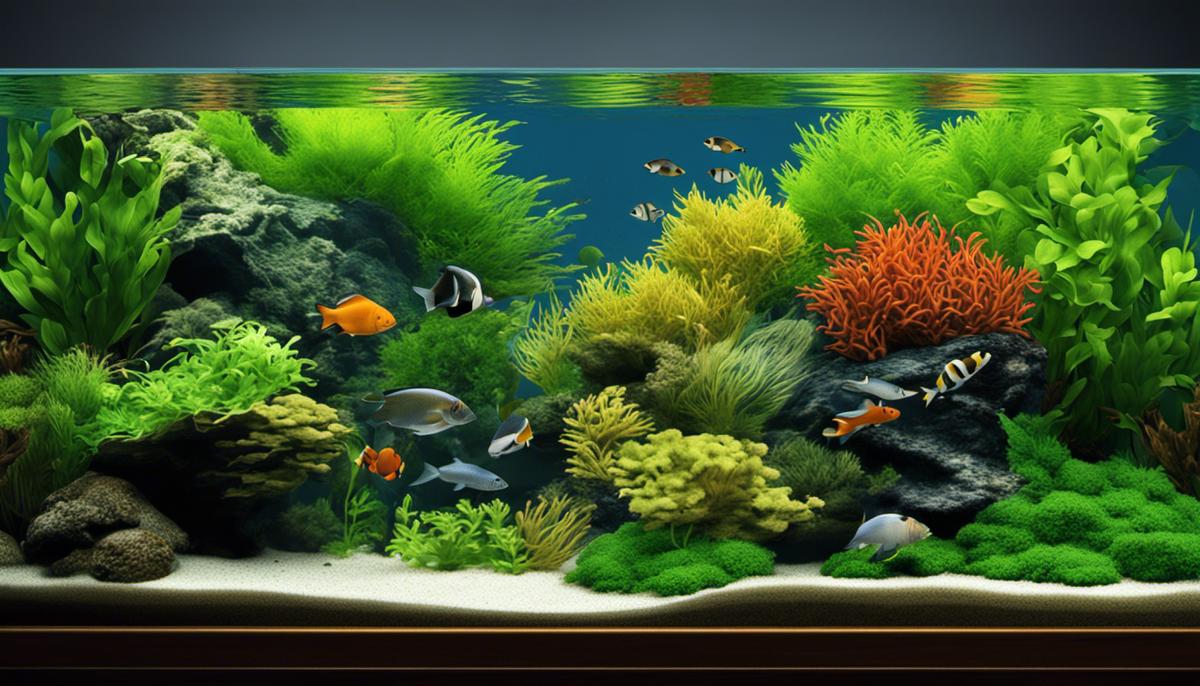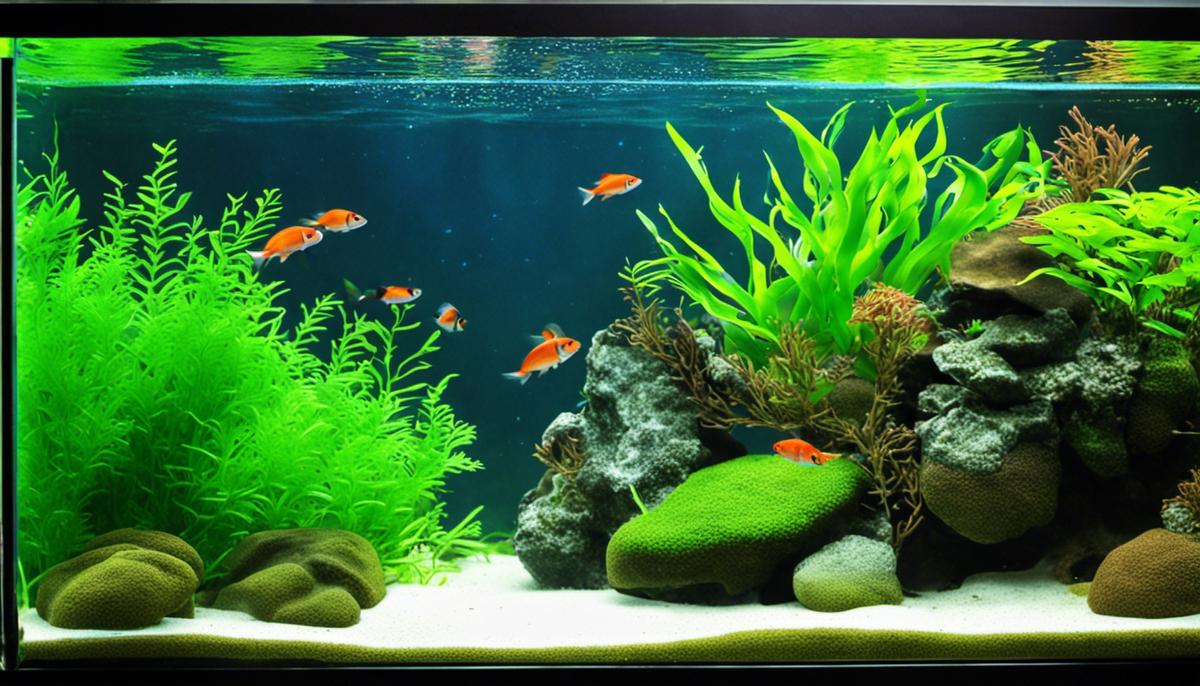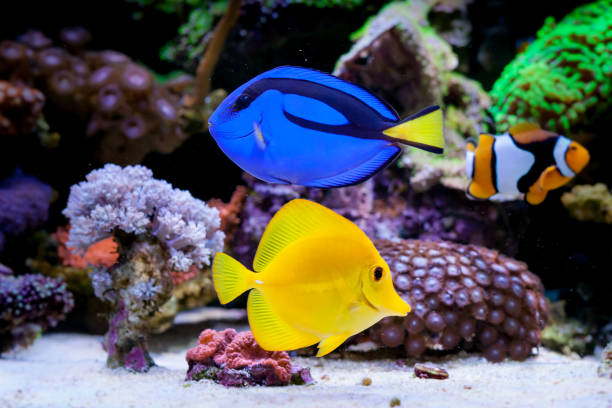If you’re an aquarium enthusiast, you probably know the rewarding experience of maintaining a healthy, visually appealing aquatic world. A common and pressing matter many aquarium keepers face is the unwanted growth of algae. While a natural part of any aquatic ecosystem, in excess, it becomes a nuisance, impairing clarity, altering water chemistry, and sometimes affecting the health of the fish. This guide delves into how to keep algae at bay, ensuring your fish live in a clean, balanced environment. By understanding the various types of algae and the conditions under which they thrive, it becomes possible to prevent their untamed growth. We’ll explore the essential role of regular tank maintenance, elective practices of a balanced aquarium ecosystem, and the use of chemical control as a last resort.
Understanding Algae and its Growth
Understanding Algae: The Unwanted Guest in Fish Tanks
Algae are ubiquitous, photosynthetic organisms that exist across a broad spectrum of types and are predominantly found in aquatic environments. In fish tanks, they can appear as green, red, brown, or even black growths on the tank walls, decorations, or substrate. Green algae are common in well-lit tanks with excess nutrients, while red and black algae usually appear in tanks with high nitrates and phosphates. Brown algae, on the other hand, are most common in new tanks with unstable water parameters.
The Algae Life Cycle: How It Grows and Thrives
Algae undergo a lifecycle similar to that of plants. They release spores into the water, which latch onto surfaces and start to grow. They utilize light and the nutrients in the water to photosynthesize and produce oxygen. Once mature, they release more spores, and the cycle continues.
Algae thrive in conditions where there is ample light and nutrients. The nutrients mostly come from fish waste, overfeeding, and decaying plant matter in the tank. Factors such as overstocked tanks, excessive light, and poor water quality can lead to an explosion of algae growth.
Climate Conditions Conducive to Algae Growth
Algae are extremely adaptable organisms that can survive in a range of environments. However, they thrive best in warm, nutrient-rich conditions. Algae prefer temperatures between 60-80°F, although some types can survive in temperatures as low as 32°F or as high as 110°F. They fare best in conditions with high light levels and long photoperiods, especially when combined with slow water movement and plenty of nutrients.
The Role of Nutrients in Algae Bloom
Nutrients and organic matter come from various sources within the aquarium, including uneaten food, fish excrement, and decaying plant matter. These provide the nitrogen and phosphorus algae need to thrive. Excessive nutrient levels in the water can also result from overstocking the tank, lack of tank maintenance, or overfeeding the fish – all of which increase the food source for algae.
Understanding the different types and growth conditions of algae is the first step in preventing their proliferation. With this knowledge, one can make informed decisions regarding lighting, feeding, stocking, temperature, and cleaning to create an environment less conducive to algae growth, ensuring a clean and healthy habitat for the inhabitants of the fish tank.

Fish Tank Maintenance
Understanding Algae Growth in Fish Tanks
Algae is a common issue in aquatic ecosystems, such as a fish tank. It can grow due to several reasons, including excessive light, nutrient-rich water, and minimal water flow. Although some amount of algae is normal, too much can be harmful to the fish and plants in the tank. To control this, regular maintenance and cleaning, water changes, and filter maintenance are required.
Routine Cleaning Responsibility in Algae Control
Cleaning your fish tank routinely is crucial in preventing the growth of algae. Algae feed on the waste products in the tank that include fish waste, uneaten food, and dead plant material. Regular cleaning reduces these waste products, essentially starving the algae and preventing its growth.
The fish tank should be cleaned weekly to keep it algae-free. Use an algae scraper or pad to remove the algae from the sides of the tank, and a gravel vacuum to siphon out the waste from the gravel or substrate.
Water Changes for Algae Prevention
In addition to routine cleaning, changing a portion of the tank’s water on a regular basis can also inhibit algae growth. This reduces the nutrients that algae need to thrive. When changing the water, you should also clean the inside walls of the tank to remove any algae forming there.
As a general rule, you should replace 10-20% of the tank’s water every week. However, the requirements may vary depending on the size of the tank, the number of fish, and the specific needs of the fish species. Make sure the new water has been dechlorinated and is the same temperature as the water in the tank.
Importance of Filter Maintenance in Algae Control
Filters play an essential role in keeping fish tanks clean and preventing algae growth. Filters remove fish waste, excess food, and other organic materials from the water that algae would otherwise feed on.
Filter pads or cartridges should be cleaned or replaced every month to ensure they function properly. Never wash them with tap water because chlorine kills the beneficial bacteria in the filter. Instead, clean the filters with the water taken out from the fish tank during water changes.
Best Practices to Prevent Algae Growth
Aside from cleaning, water changes, and filter maintenance, some other best practices can also help prevent the algae growth. Keep the fish tank out of direct sunlight and limit the use of artificial light to 8-10 hours a day. Overfeeding the fish can also lead to more waste, contributing to algae bloom, hence, feed the fish only what they can consume in two to five minutes.
In conclusion, preventing algae growth in your fish tank involves a combination of routine cleaning, regular water changes, filter maintenance, and responsible feeding practices. These tasks performed diligently and regularly will help keep the tank clean and the fish healthy.

Balancing the Aquarium Ecosystem
Understanding the Aquarium Ecosystem: Algae Growth
Algae growth in fish tanks can be both Beneficial and problematic; a controlled amount contributes to a healthy ecosystem, but too much can disrupt the balance and harm your aquatic pets. This overgrowth often occurs due to excessive light, overfeeding of fish, lack of live plants, and absence of algae-eating fish and creatures.
Light Control: Keys to Balancing
One major cause of algae overgrowth in fish tanks is excessive lighting. Algae, like all plants, photosynthesize light for growth, and access to too much light can lead to rapid expansion. To control this, limit the exposure of your tank to natural light as direct sunlight can accelerate algae growth. Similarly, ensure your tank lights are only on for around 8 to 12 hours per day; any longer and you risk promoting algae overgrowth. Using a timer for the tank lights can aid in keeping this balance.
Paying Attention to Feeding
Feeding your fish properly plays a significant role in maintaining the balance of the aquarium. Overfeeding can result in leftover food which decomposes in the water and produces excess nutrients for algae, leading to rapid growth. Always provide only as much food as your fish can consume in a few minutes and remove any leftovers promptly.
The Role of Live Plants
Live plants can significantly prevent the growth of algae in your fish tank. They compete with algae for light and essential nutrients, limiting the resources available for the algae to thrive. Thus, maintaining a good number of live plants in your tank can effectively mitigate algae growth.
Benefitting from Algae-Eating Species
Algae-eating fish and invertebrates contribute to controlling algae in an aquarium. These organisms feed on algae as their primary food source, thus keeping the algae population in check. Common algae-eating fish include the Bristlenose Pleco and the Siamese Algae Eater. Invertebrates like shrimp and certain species of snails also consume algae.
By following these steps to control lighting and feeding, as well as incorporating live plants and algae-eating species into your fish tank, you can effectively prevent algae overgrowth, maintaining a balanced and healthy aquarium ecosystem.

Chemical Algae Control
Understanding The Role of Chemicals in Controlling Algae Growth
Chemicals and additives can play an important role in controlling algae growth within a fish tank environment. While a mild presence of algae is considered healthy and plays a vital role in maintaining the biological balance of the tank, an uncontrolled growth can be a cause for concern. Algae can quickly take over a tank, making the water murky and hurting the overall health of the fish and other aquatic pets. Chemicals and additives can help control this overgrowth.
Choosing the Right Algae Control Products
There isn’t a one-size-fits-all product when it comes to managing algae growth. The chemical or additive you need will depend on the type of algae growing. Green water or single-cell algae (like spirulina), for instance, can be controlled with ultraviolet sterilizers. Chemicals like Algaecides and algicides are designed to control different types of algae and can be very effective. However, make sure to research the specific type of algae you’re dealing with to make sure you get the right product.
Recognizing Potential Risks
While efficient, chemicals should always be used with caution. They can cause unintended harm to your fish or plants if not used correctly. Excessive use of these chemicals can lead to the death of your fish and can disturb the biological balance of your aquarium. Further, some fish and invertebrates are more sensitive to these chemicals than others. Overdosing can adversely impact, or even prove fatal, to such species.
Proper Administration of Chemicals
Here are steps to properly administer algicides or algaecides in your fish tank:
- Always start by reading the product label. It contains crucial information about dosages and safety precautions.
- Perform a large water change before you begin the treatment. This reduces the number of algae present and makes the treatment more efficient.
- Use the exact dosage recommended on the product label. Overdosing can cause harm to your fish, invertebrates, and beneficial bacteria.
- After applying algaecide or algicide, keep a close eye on your fish. If they start showing signs of distress, perform a partial water change to dilute the chemical concentration.
- Finally, consider carbon filtration post chemical treatment to remove any remaining traces of the algicide or algaecide.
Balancing Mechanical and Chemical Algae Control
While chemicals can be a real help, mechanical prevention should also be considered. This can include regular water changes, reducing feeding, and physically removing excess algae. Algae thrive on light and nutrients, so looking at source control such as reducing light hours and using plants to outcompete algae for nutrients can also be beneficial. A balanced approach between chemical control and mechanical preventative measures will yield the most effective results.
Remember, prevention is better than cure. It’s easier to prevent an algae bloom than to deal with one that’s already in full swing. If you’re diligent about maintenance and give your fish tank the care it needs, you can reduce the chances of an outbreak significantly.

Ultimately, dealing with algae is an inevitable part of owning a fish tank. But that doesn’t mean you have to let it overrun your aquarium. Embrace the challenge, and take comfort in knowing you’re not alone — countless aquarium owners have successfully tackled this issue and so can you. With an informed understanding of algae and its biology, a regular maintenance regime, a balanced aquarium ecosystem, and the careful use of chemicals when necessary, you have an arsenal of tools at your disposal. May this guide empower you to create the vibrant, clear, and healthy fish tank that both you and your aquatic friends will enjoy.
ChasingNemo.com is a participant in the Amazon Services LLC Some of the links in our posts are affiliate links. Click Here For Full Disclosure.







